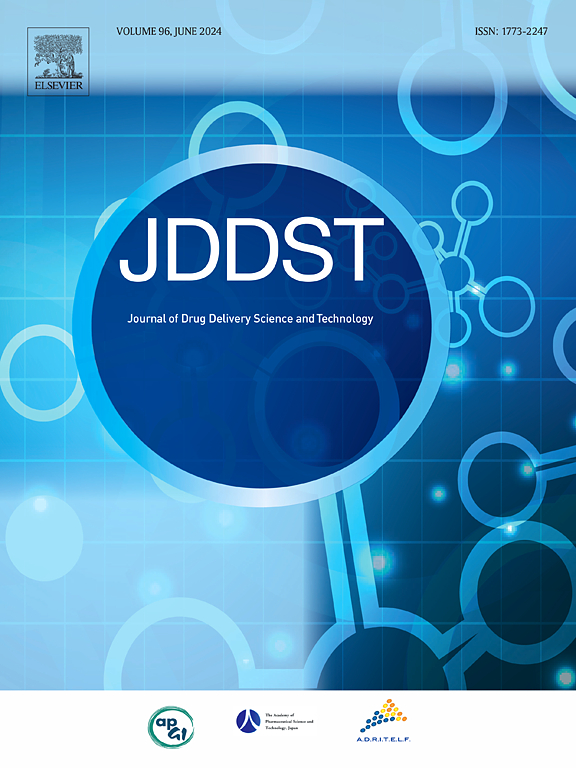利用铜和铁基金属有机框架作为创新纳米载体,增强氟康唑在白色念珠菌局部治疗中的传递
IF 4.5
3区 医学
Q1 PHARMACOLOGY & PHARMACY
Journal of Drug Delivery Science and Technology
Pub Date : 2025-03-25
DOI:10.1016/j.jddst.2025.106854
引用次数: 0
摘要
真菌感染对医疗保健构成了重大挑战,目前的治疗方法往往受到低疗效和副作用的限制。本研究探讨了氟康唑(FLCZ)负载金属有机框架(MOF)作为新型纳米载体,通过协同作用和药物释放控制来增强抗真菌治疗。将铜(Cu)和铁(Fe)金属与合适的连接剂通过室温转化法合成的MOF用Carbopol®971 NP转化为外用凝胶。综合评价表明,铜基和铁基MOF凝胶透明半透明,具有皮肤相容性pH值(分别为5.96±0.07和5.02±0.04),药物含量高(> 98% w/w),具有良好的应用性能,包括假塑性流动,良好的涂抹性(35±2 mm和23±3 mm),高粘度(6489.33±7.15 cps和6247.41±5.69 cps)。药物释放研究显示,Cu-和Fe-MOF凝胶的持续分布遵循Higuchi基质扩散控制机制。体外抗真菌研究表明,与市场上销售的制剂相比,该制剂具有更大的抗白色念珠菌区域,表明其具有协同作用机制。急性皮肤毒性评估证实了MOF凝胶的安全性,具有最小的皮肤刺激和改善的组织学结果。这项研究强调了基于mof的凝胶作为真菌感染的先进纳米载体系统的潜力,提供控制释放,增强抗真菌活性,降低皮肤毒性,为有效的靶向抗真菌治疗铺平了道路。本文章由计算机程序翻译,如有差异,请以英文原文为准。

Harnessing Cu- and Fe-based metal-organic frameworks as innovative nanocarriers for enhanced fluconazole delivery in topical management of Candida albicans
Fungal infections pose significant challenges in healthcare, with current treatments often limited by low efficacy and side effects. This study explores fluconazole (FLCZ) loaded metal-organic frameworks (MOF) as innovative nanocarriers to enhance antifungal therapy through synergistic action and controlled drug release. MOF synthesized using copper (Cu) and iron (Fe) metals with suitable linker via the room temperature conversion method were converted into topical gels using Carbopol® 971 NP. Comprehensive evaluations revealed that the Cu- and Fe-based MOF gels were clear and translucent, with skin-compatible pH (5.96 ± 0.07 and 5.02 ± 0.04, respectively), high drug content (>98 %w/w), and favorable application properties, including pseudoplastic flow, good spreadability (35 ± 2 mm and 23 ± 3 mm), and high viscosity (6489.33 ± 7.15 cps and 6247.41 ± 5.69 cps, respectively). Drug release studies showed sustained profiles with Cu- and Fe-MOF gels following a Higuchi matrix diffusion-controlled mechanism. In-vitro antifungal studies demonstrated enhanced efficacy, with larger zones of inhibition against Candida albicans compared to marketed formulation, indicating a synergistic mechanism of action. Acute dermal toxicity assessment confirmed the safety of MOF gels, with minimal skin irritation and improved histological outcomes. This investigation highlights the potential of MOF-based gels as advanced nanocarrier systems for fungal infections, offering controlled release, enhanced antifungal activity, and reduced skin toxicity, paving the way for effective, targeted antifungal therapies.
求助全文
通过发布文献求助,成功后即可免费获取论文全文。
去求助
来源期刊
CiteScore
8.00
自引率
8.00%
发文量
879
审稿时长
94 days
期刊介绍:
The Journal of Drug Delivery Science and Technology is an international journal devoted to drug delivery and pharmaceutical technology. The journal covers all innovative aspects of all pharmaceutical dosage forms and the most advanced research on controlled release, bioavailability and drug absorption, nanomedicines, gene delivery, tissue engineering, etc. Hot topics, related to manufacturing processes and quality control, are also welcomed.

 求助内容:
求助内容: 应助结果提醒方式:
应助结果提醒方式:


